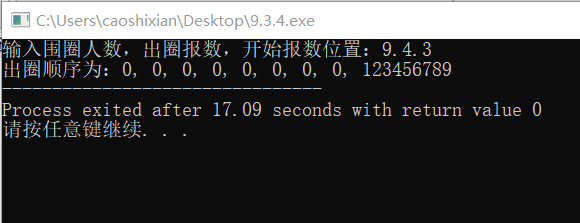C程序设计实验报告
实验项目:
1、结构体变量的应用
2、结构体数组的应用
3、共用体的应用
4、结构体指针的应用
姓名:曹时仙 实验地点:教学楼 实验时间2019.6.26
一、本章要点
1、对结构体和共用体的概念进行区分,学会定义变量和使用变量。
2、结构类型的定义可以嵌套,结构类型与联合类型的定义也可以相互嵌套,只是要注意被嵌套的类型必须先有定义。
3、将指针、数组与结构体或共用体相结合来实现数据的输入输出。
4、要了解各种函数的作用,例如:abort(),strmcmp()等。
二、实验内容
1、结构体变量的应用
问题的简单描述:试利用结构体类型描述年、月、日,输入一个日期,统计日期是本年度第多少天。算法描述如图:
实验代码
#include<stdio.h>
main()
{
struct date
{
int years;
int month;
int day;
}a;
int i, days;
printf("输入年,月,日:");
scanf("%d,%d,%d",&a.years,&a.month,&a.day);
for(i=1;i<a.month;i++)
{
if(i==1||i==3||i==5||i==7||i==8||i==10)days+=31;
else if(i==4||i==6||i==9||i==11)days+=30;
else if(a.years%400==0) days+=29;
else days+=28;
}
days+=a.day;
printf("%d年%d月%d日是该年的第%d天",a.years,a.month,a.day,days);
}
问题分析:这题主要问题在如在if语句内表达i是几月份,然后就是最后的输出结果的表达。
运行结果:
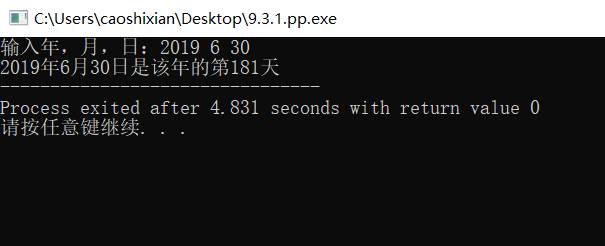
2、结构体数组的应用
问题的简单描述:在选举中,假设有6位候选人,有10个人参加投票(只能对一位候选人投票),用结构体数组统计各候选人的得票数。算法描述如图:
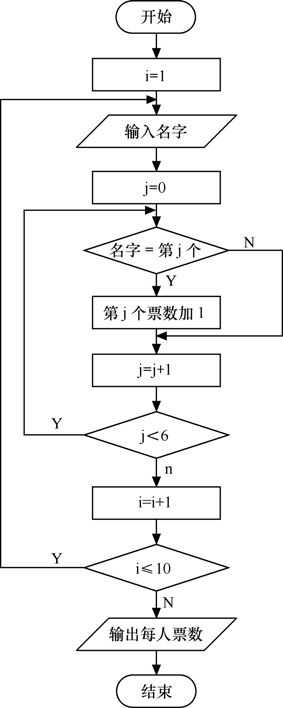
实验代码:
#include"stdio.h"
#include<string.h>
struct person
{
char name[20];
int count;
}a[6]={"zhang",0,"li",0,"wang",0,"zhao",0,"liu",0,"zhu",0};
main()
{
int i,j; char abc[20];
for(i=1;i<=10;i++)
{
printf("输入候选人名字:");
scanf("%s",&abc[i]);
for(j=0;j<6;j++)
if(strcmp(a[j].name,&abc[i])==0)a[j].count+=1;
}
for(j=0;j<6;j++)
printf("%s:%d
",a[j].name,a[j].count);
}
问题分析:该题主要难点在判断if语句中的“若第j个候选人名字与输入的名字相同”,这里需要用上strcmp函数进行比较。
运行结果:

3、共用体的应用
问题的简单描述:编写程序填写表格。从键盘输入学生和教师的信息,若是学生,则班级/职务栏填入班级;若是教师,则班级/职务栏填入职称。算法描述如图:
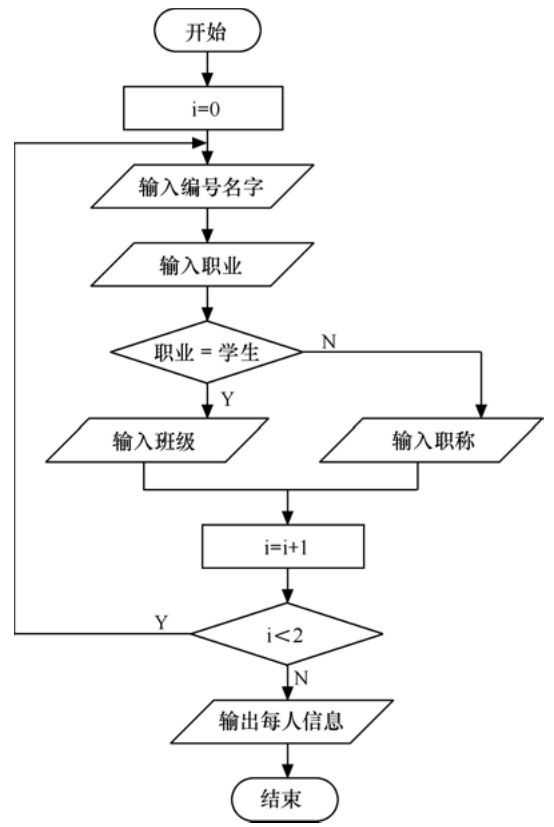
实验代码:
#include<stdio.h>
#include<stdlib.h>
struct
{
int number;
char name[30];
char job;
union
{
int classes;
char position[10];
}category;
}person[2];
main()
{
int i;
for(i=0;i<2;i++)
{
printf("请输入编号、姓名、职业:");
scanf("%d%s%s",&person[i].number,&person[i].name,&person[i].job);
if(person[i].job=='s')
{
printf("请输入班级:");
scanf("%d",&person[i].category.classes);
}
else if(person[i].job=='t')
{
printf("请输入职务:");
scanf("%s",&person[i].category.position);
}
else
{
printf("input error!");
abort();
}
}
printf("
");
printf("编号 姓名 职业 班级/职务
");
for(i=0;i<2;i++)
{
if(person[i].job=='s')
{
printf("%d ",person[i].number);
printf("%s ",person[i].name);
printf("%c ",person[i].job);
printf("%d
",person[i].category.classes);
}
else
{
printf("%d ",person[i].number);
printf("%s ",person[i].name);
printf("%c ",person[i].job);
printf("%s
",person[i].category.position);
}
}
}
问题分析:这题问题较大,问题出在教科书上,name是指针,把name改成数组就好了,后来老师在课堂上解决了
运行结果:
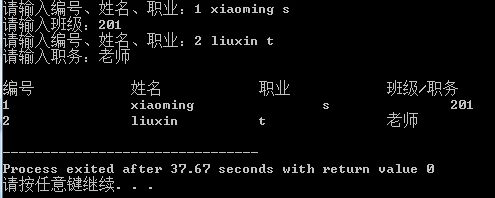
4、结构体指针的应用
问题的简单描述:n个人围成一圈,从第s个人开始按顺时钟1,2,3.....,m的顺序报数,数到m的人出圈,然后从出圈的下一个人开始重复此过程,输入所有出圈人的顺序。n,s,m从键盘输入。算法描述如下:
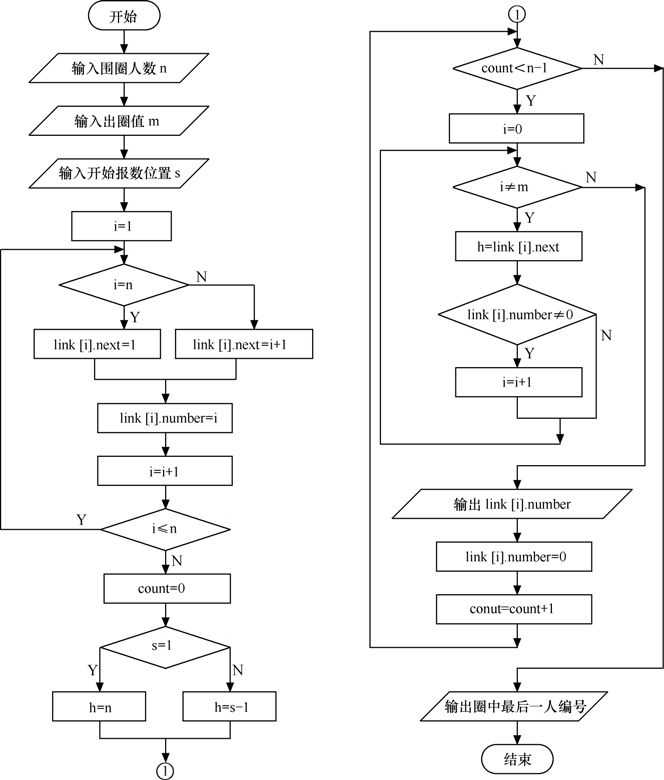
实验代码:
#include<stdio.h>
#define N 10
struct child
{
int no;
int next;
};
struct child link[N];
main()
{
int i,n,m,s,count,h;
printf("输入围圈人数,出圈报数,开始报数位置:");
scanf("%d%d%d",&n,&m,&s);
for(i=1;i<=n;i++)
{
if(i==n)
link[i].next=1;
else
link[i].next=i+1;
link[i].no=i;
}
count=0;
if(s==1)h=n;else h=s-1;
printf("出圈顺序为:");
while(count<n-1)
{
i=0;
while(i!=m)
{
h=link[h].next;
if(link[h].no)
i++;
}
printf("%d, ",link[h].no);
link[h].no=0;
count++;
}
for(i=1;i<=n;i++)
{
if(link[i].no!=0)
printf("%d",link[i].no);
}
}
问题分析:主要问题是变量繁多,容易搞错,其他没什么。
运行结果:
